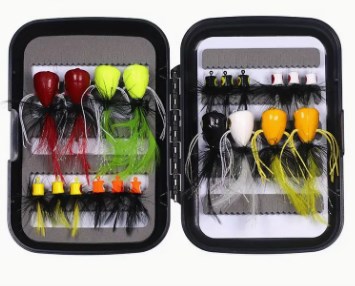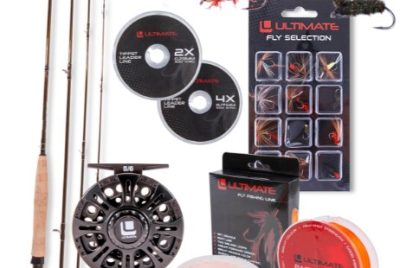Fly Fishing for Bass with Poppers
Introduction
Ah, the exhilarating pursuit of bass with fly fishing techniques! Join me as we dive into the world of fly fishing for bass with poppers, a technique that combines the artistry of fly casting with the explosive strikes of bass hunting prey on the water’s surface.
Understanding Fly Fishing for Bass

Fly fishing holds a special allure for anglers seeking a more immersive and challenging fishing experience. Unlike traditional bait or lure fishing, fly fishing relies on the weight of the fly line to cast lightweight artificial flies, requiring precision and finesse to entice fish to strike.
What are Poppers?
Poppers are a type of fly fishing lure designed to mimic the movements of surface-dwelling prey, such as insects or small baitfish. Constructed with a buoyant body and a concave face that creates a popping or splashing action when retrieved, poppers are irresistible to bass lurking in shallow waters.
Benefits of Using Poppers
The use of poppers in bass fly fishing offers several distinct advantages. Their surface-skimming action elicits aggressive strikes from bass, making for heart-pounding encounters that ignite the angler’s adrenaline. Additionally, poppers are highly versatile and effective in various water conditions, from calm lakes to flowing rivers.
Choosing the Right Gear
To maximize success when fly fishing for bass with poppers, it’s essential to select the right gear. A medium to medium-heavy fly rod with a fast action paired with a weight-forward floating fly line and a sturdy leader is ideal for casting and controlling poppers with precision and accuracy.
Techniques for Fishing with Poppers

Mastering the art of presenting poppers to bass requires finesse and skill. Experiment with different retrieval techniques, such as the traditional pop-and-stop retrieve or the more aggressive stripping action, to trigger aggressive strikes from bass lurking beneath the surface.
Best Time and Places for Bass Fly Fishing with Poppers
Timing is crucial when targeting bass with poppers. Early mornings and late evenings are prime times for bass activity, as they are more likely to be feeding near the surface. Look for areas with submerged structure, such as fallen trees or rocky outcrops, where bass tend to congregate.
Reading Bass Behavior
Understanding bass behavior is key to success in fly fishing. Pay attention to environmental factors such as water temperature, weather conditions, and seasonal patterns to predict bass movements and feeding habits. Observation and patience are essential skills for anticipating and capitalizing on bass strikes.
Fly Tying: Making Your Own Poppers
Crafting your own popper flies adds a personal touch to your bass fly fishing adventures. Experiment with different materials, colors, and sizes to create custom poppers tailored to mimic the natural prey species found in your local waters. Not only is fly tying a creative outlet, but it also allows you to fine-tune your presentations for maximum effectiveness.
Etiquette and Conservation

As stewards of the environment, it’s important for anglers to practice responsible fishing ethics and conservation principles. Respect fishing regulations and practice catch-and-release whenever possible to preserve bass populations for future generations of anglers to enjoy.
Benefits of Bass Fly Fishing with Poppers
The thrill of hooking into a feisty bass on the surface with a popper is unmatched in the world of fishing. The explosive strikes, acrobatic leaps, and adrenaline-fueled battles make bass fly fishing with poppers a truly exhilarating and memorable experience that keeps anglers coming back for more.
Challenges and Solutions
While fly fishing for bass with poppers presents its challenges, such as casting accuracy and lure presentation, these obstacles can be overcome with practice and persistence. Take the time to hone your casting skills and experiment with different popper designs and techniques to find what works best for you.
Safety Considerations
Safety should always be a top priority when venturing out onto the water. Wear appropriate safety gear, such as a life jacket or personal flotation device (PFD), and familiarize yourself with local water hazards and regulations before setting out on your bass fly fishing adventures.
Conclusion

In conclusion, fly fishing for bass with poppers offers an immersive and rewarding angling experience that combines skill, strategy, and excitement. Whether you’re a seasoned fly angler or new to the sport, exploring the world of bass fly fishing with poppers is sure to ignite your passion for fishing and create memories to last a lifetime.
FAQs
1. Can I use the same fly rod for bass fly fishing with poppers as I do for other types of fly fishing?
Yes, a medium to medium-heavy fly rod with a fast action is suitable for both bass fly fishing with poppers and other fly fishing applications. However, consider matching the rod weight to the size of poppers and flies you plan to use for optimal performance.
2. What are the best colors and sizes of poppers for bass fly fishing?
Natural colors such as white, yellow, and chartreuse are effective for poppers, as they mimic the appearance of prey species commonly found in bass habitats. Sizes ranging from 2 to 4 inches are ideal for imitating small baitfish and insects.
3. How do I know if a bass has taken my popper fly?
Watch for subtle movements or twitches in the fly line, indicating that a bass has taken the popper. Feel for any resistance or changes in line tension, and be prepared to set the hook with a quick strip strike or upward rod motion to secure the catch.
4. What type of retrieve is most effective for fishing with poppers?
Experiment with different retrieval techniques, such as the traditional pop-and-stop retrieve, the steady retrieve, or the walk-the-dog retrieve, to determine which elicits the most strikes from bass. Vary your retrieve speed and rhythm to mimic the natural movements of prey species.
5. Are there any specific water conditions or weather patterns that are ideal for bass fly fishing with poppers?
Bass are more likely to feed near the surface in low-light conditions, such as early mornings and late evenings, or on overcast days when visibility is reduced. Look for areas with calm or slightly rippled water, as bass are more responsive to surface lures in these conditions.



